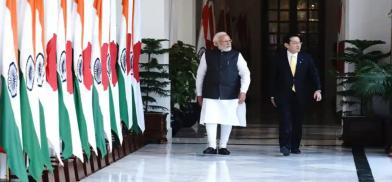Japanese PM Kishida's Delhi visit: The missing buzz about Japanese investments in India
The Japan Bank for International Cooperation listed India as the most attractive investment destination, yet Prime Minister Fumio Kishida’s visit to Delhi failed to generate that investment buzz, writes S. Majumder for South Asia Monitor

Japanese Prime Minister Fumio Kishida’s rise to the leadership of his country's ruling Liberal Democratic Party (LDP), pipping other contenders, earned media prominence. Kishida, former Prime Minister Shinzo Abe’s handpicked successor, is the 100th Prime Minister of Japan. He vowed to counter China’s growing influence by closely working with the US and other like-minded democracies.
He is the first prime minister from any country to make a physical visit to India amid the dragging Covid-19 pandemic. This raised eyebrows on the urgency behind the trip when the global focus is on Russia’s invasion of Ukraine. Although his coming made Indian policymakers happy, with Japanese economic investment rising from $33 billion to $42 billion in the next five years, there were more expectations.
Nevertheless, the joint statement issued after the visit fell short of focusing on Japanese investment in India, which nosedived by 39.5 percent in 2020-21, against a jump of 8.8 percent in 2019-20 and 81.6 percent in 2018-19.
The fall raised eyebrows against the backdrop that total FDI in India surged during the Covid-19 pandemic. The sole reason was US investment, which increased by 227.3 percent in 2020-21, followed by the UK (43.6 percent growth).
India needs FDI
Foreign investment is the need of the day for India to ensure its economy bounces back. Investment has been the core issue for strong economic ties between India and Japan. Japanese investment is known for bringing India on the global map for automobiles. Against this backdrop, relative silence over Japanese investment raised surprises among the Indian business community who sought a Japanese government initiative to restore investor confidence.
Why have the Japanese investors turned apathetic towards India? A section of the analysts argued that the downturn in profitability and losses suffered by large Japanese investors dimmed Japanese sentiments. More than 50 percent of Japanese investors surveyed in India projected losses in their operating profits in 2020. This is the highest among all nations that have Japanese investment in the world.
Ironically, the ratio of losses in China was at a low margin -- 19.5 percent. This reflects that even though the Japanese government advocated incentives for decoupling from China and move to other Asian nations during the pandemic, Japanese investors were reluctant to shift to India.
Abe embraced India
During the Abe regime, Indo-Japan relations saw new dynamism. There was a paradigm shift from mere bilateral economic relations to special strategic relations, including defence and global partnership. The relationship extended to joint partnership for economic development in third countries and defence cooperation. Development of AAGC (Asia-Africa Growth Corridor) project, joint cooperation for the development of Chabahar Port in Iran and strengthening of defence cooperation with MoU in defence cooperation led to a new dimension in political and economic partnership.
Thanks to the Abe administration, a new strategy for defence cooperation was adopted for 2+2 Foreign and Defence Ministerial meetings in November 2019. Japan was the second country, after the US, with which India had such a dialogue format, with an eye on countering China's expansionism. The two sides provided opportunities to give a strong spine to India-Japan special strategic and global partnership.
The rise of China was a major concern for India and Japan. "Any loss to China is a gain to India" became a new catchphrase. India poses a challenge to become an alternative destination for low-cost manufacturing. According to a Deloitte survey, India would be the "New China" in low-cost manufacturing countries in the next five years.
China vs India
With China losing the reputation powerhouse of low-cost manufacturing competitiveness, five Asia Pacific nations would emerge as the choice for low-cost manufacturing destinations. They are Malaysia, Thailand, Indonesia, Vietnam and India. India would be the front-runner, the survey said.
The Japan Bank for International Cooperation (JBIC), in its 31 surveys in 2019, listed India as the most attractive investment destination, with China and Vietnam in second and third positions respectively. In other words, China's drop in attractiveness paved the way for India to rise to the top as an investment hub for Japan. The India-Japan strategic partnership and engagement in defence cooperation demonstrate a major transformation in the India-Japan relationship from bilateral economy issues to political dynamism during the Abe regime. Eventually, the strategic partnership led to a splurge in Japanese investment in India.
However, the visit of Kishida failed to echo that buzz about Japanese investments in India. India has a free trade agreement (FTA) with Japan. But it failed to reinvigorate Japanese investment sentiments in India. India's new foreign trade policy is likely to focus on FTA as a driving force to expand exports through the global supply chain trade.
(The writer is a former Adviser, Japan External Trade Organization, New Delhi. Views are personal.)










Post a Comment